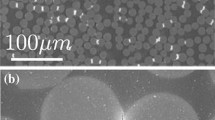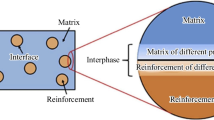Abstract
The mechanical behavior of fiber-reinforced composites is largely determined by adhesion at the fiber-matrix interface. Thus, a fundamental understanding of the interfacial region and a quantitative characterization of the level of interfacial adhesion can contribute to an evaluation of the mechanical behavior and performance of composite materials. Among numerous techniques for interface characterization, the vibration damping method has attracted continually more attention because it provides sensitive and nondestructive detection of the interfacial region in composites. In the research presented here, a new optical system for measuring vibration damping was introduced, and a model for evaluating the interfacial adhesion between fiber and matrix from a damping parameter was developed. A quantitative relationship between the dynamic (vibration damping) and static (interfacial shear strength) adhesion measurements was established. The experimental data from glass-fiber-reinforced epoxy resin composites with different interfacial treatments showed good agreement with the theoretical model.
Similar content being viewed by others
References
L.T. Broutman, Polymer Eng. Sci., 6 (1966), p. 1.
J.P. Favre and J. Perrin, J. Mat. Sci., 7 (1972), p. 1113.
B. Miller, P. Muri, and L. Rebenleld, Camp. Sci. Tech., 28 (1987), p. 17.
H.E. Wu and M.K. Ferber, J. Adhesion, 45 (1994), p. 89.
J.E. Mandell, E.J.H. Chen, and E.J. McGarry, Internat. J. Adhesion Adhesives, 1 (1980), p. 40.
C.E. Zorowski and T. Murayama, Proc. 1st Int. Conf on Mech Behav. of Mater., 5 (Kyoto, Japan: Soc. of Mater. Sci., 1972), p. 28.
L. Meirovitch, Elements of Vibration Analysis, ed. B.J. Clark and M.E. Margolies (New York: McGraw-Hill, 1975).
G. Levy, Wear, 64 (1980), p. 57.
J. Ogden Outwater, Jr., Modern Plastics (March 1956), p. 56.
J.P. Den Hartog, Mechanical Vibrations (New York: McGraw-Hill, 1985).
E. Volterra and E.C. Zachmanoglou, Dynamics of Vibrations (Columbus, OH: Charles E. Merrill, 1965), p. 321.
K. Clark, Dynamics of Continuous Elements (Englewood Cliffs, NJ: Prentice-Hall, 1972), p. 75.
M. Weller and Hassel Ledbetter, J. Mater. Res., 5 (5) (1990), p. 913.
L.B. Crema, A. Caastellani, and A. Serra, J. Composite Materials, 23 (1989), p. 978.
R.F. Gibson and R. Plunkett, J. Composite Materials, 10 (1976), p. 325.
Author information
Authors and Affiliations
Rights and permissions
About this article
Cite this article
Wu, H.F., Gu, W. & Lu, GQ. A model for predicting micromechanical interfacial adhesion in polymer composites. JOM 48, 58–61 (1996). https://doi.org/10.1007/BF03223077
Issue Date:
DOI: https://doi.org/10.1007/BF03223077




